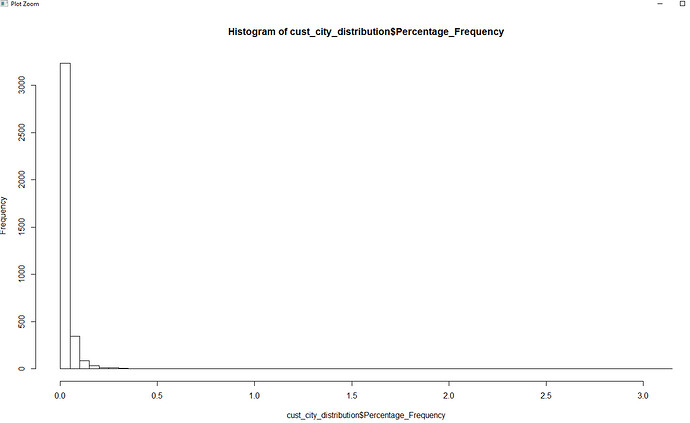Hello,
I have a sample data:
Summary
> cat(wrapr::draw_frame(head(cust_city_distribution,30)))
build_frame(
"CUST_CITY" , "frequency", "Percentage_Frequency" |
"Aberdeen ", 6L , 0.01167 |
"ABERDEEN ", 2L , 0.003889 |
"ABILENE ", 16L , 0.03111 |
"Abingdon ", 1L , 0.001944 |
"ABINGDON ", 6L , 0.01167 |
"ACTON ", 16L , 0.03111 |
"Acworth ", 2L , 0.003889 |
"Ada ", 9L , 0.0175 |
"ADA ", 10L , 0.01944 |
"ADAIRSVILLE ", 8L , 0.01555 |
"ADRIAN ", 10L , 0.01944 |
"AIEA ", 4L , 0.007777 |
"Aiken ", 7L , 0.01361 |
"AIKEN ", 43L , 0.0836 |
"AKRON" , 18L , 0.035 |
"Akron ", 1L , 0.001944 |
"AKRON ", 5L , 0.009721 |
"Alabaster ", 1L , 0.001944 |
"ALABASTER ", 1L , 0.001944 |
"Alamogordo ", 9L , 0.0175 |
"Albany ", 16L , 0.03111 |
"ALBANY ", 48L , 0.09333 |
"ALBERTVILLE ", 19L , 0.03694 |
"Albion ", 2L , 0.003889 |
"Albuquerque ", 32L , 0.06222 |
"ALBUQUERQUE ", 14L , 0.02722 |
"ALEXANDER CITY ", 17L , 0.03305 |
"Alexandria ", 2L , 0.003889 |
"ALEXANDRIA ", 19L , 0.03694 |
"ALGONQUIN ", 1L , 0.001944 )
I am trying to produce a histogram which basically tells me which the cities' frequency distribution so I can drop some cities which have low frequencies.
The reason I am doing this is because I need to run a decision tree analysis and one of the dead blocks I am running into is that the factor "city" has 3764 or something levels.
I can produce a history but since the x-axis has so many small values (I think the percentage can go as low as 0.001 or lower), I cannot visualize the plot well enough to make a decision which city to keep in my analysis and which city to drop.
Thanks!
